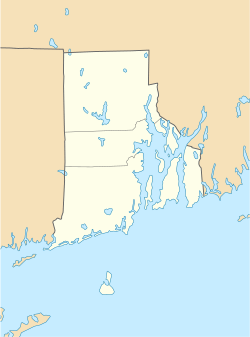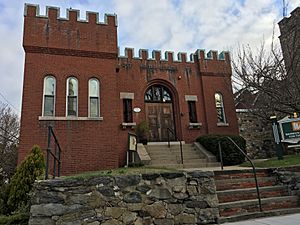Warwick Civic Center Historic District facts for kids
Quick facts for kids |
|
|
Warwick Civic Center Historic District
|
|
 |
|
| Location | Warwick, Rhode Island |
|---|---|
| Built | 1890 |
| Architect | William R. Walker & Son; Hoppin, Field & Peirce; Jackson, Robertson & Adams |
| Architectural style | Colonial Revival |
| NRHP reference No. | 80000079 |
| Added to NRHP | June 27, 1980 |
The Warwick Civic Center Historic District is a special area in Warwick, Rhode Island. It includes three important buildings that are part of the city's history. A historic district is a place where buildings, structures, or sites are kept safe because they are important to history.
These buildings are Warwick City Hall, the Henry Warner Budlong Memorial Library, and the Kentish Artillery Armory. They are all located on Post Road in the Apponaug village area. This area was first settled way back in the 1600s!
Contents
History of the Civic Center
The buildings in this district were built between 1890 and 1925. They show how the city grew and changed over time. An old fire station was once part of this district, but it has since been taken down.
In 1980, the Warwick Civic Center Historic District was added to the National Register of Historic Places. This means it's officially recognized as an important historical site in the United States.
Important Buildings in the District
Kentish Artillery Armory, 3259 Post Road
This building was finished in 1912. It stands where an older armory, built in 1854, once stood before it burned down. An armory is a place where military groups store weapons and train.
The famous Rhode Island architects William R. Walker & Son designed this new building. They made it look like a castle, which was a popular style at the time. The building was used by the Kentish Guard, a local military group, until 1977.
After that, the building was given to the city. Now, it's home to the Warwick Museum of Art, where you can see amazing art!
- Missing Cannons: Two cannons from the American Revolution used to be on the front of the building. But they disappeared in 1972 and have never been found. Today, you'll see two wooden copies in their place.
Henry Warner Budlong Memorial Library, 3267 Post Road
This building is now the Apponaug branch of the Warwick Public Library. It was built in 1924-1925. It became the home for the Apponaug Free Library Association.
A kind local helper named Henry W. Budlong gave the money to build it. The building was designed by the firm of Hoppin, Field & Peirce from Providence, Rhode Island. They used a simple version of the Classical Revival style.
- Changes Over Time: The front entrance used to have two round columns. These were taken away in the 1970s. The original doors were also changed, but a fancy decoration above the door is still there.
Warwick City Hall, 3275 Post Road
This is the biggest building in the district. It was also designed by William R. Walker & Son. It replaced older town buildings from the 1830s.
City Hall is a very important building in Warwick. It was designed in the Queen Anne and Colonial Revival styles. When the towns of Warwick, Rhode Island and West Warwick, Rhode Island split up, this building was a big topic of discussion. Warwick kept City Hall.
- City Archives: In 1929, an addition was built on the back of City Hall. This part was designed by Jackson, Robertson & Adams. It holds all the city's important historical documents and records.
- War Memorial: Outside City Hall, there's a memorial for soldiers from World War I. It was dedicated in 1919. A local artist, John G. Hardy, created it.
- Restoration Work: City Hall started to look a bit old in the 1980s. So, people began to restore it. First, they fixed the outside. Then, they worked on the inside in the 1990s. More work was done in 2013. This made the clock and bell in the tower work again!




